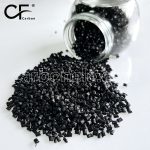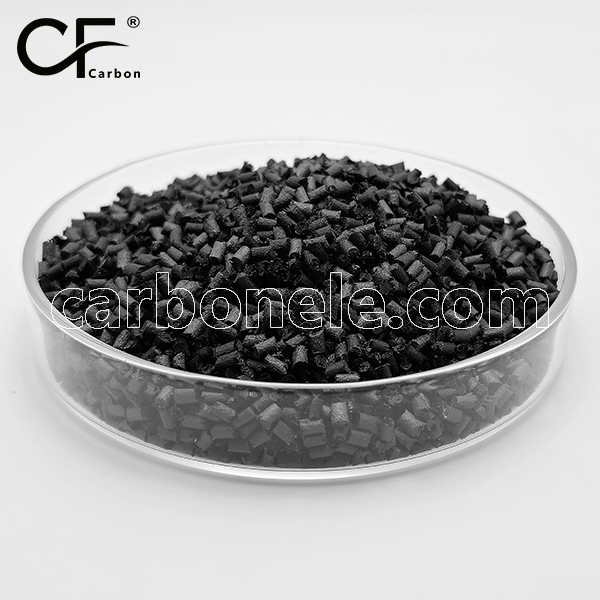
Polypropylene Reinforced Carbon fiber PP-CF5
PP-CF5 is a polypropylene-reinforced composite material that offers enhanced rigidity, strength, weight reduction, chemical resistance, good processing performance, and wide applications in automotive parts, electronic housings, industrial equipment, and consumer products.
- Model number: PP-CF-BAC05
- Matrix Resin: Polypropylene
- Reinforcing Filler: Carbon fiber
- Appearance: Granules
- Grade: Injection/extrusion grade
- Packaging: 25kgs/bag
Polypropylene reinforced with 5% carbon fiber, or PP-CF5, is a state-of-the-art composite material that combines the benefits of polypropylene (PP) with the exceptional strength and stiffness provided by carbon fibers. Because of its special qualities, this material is well-suited for a variety of demanding applications and has gained appeal across several industries.
PP-CF5 mechanical characteristics
The improved mechanical qualities of PP CF5 are one of its key benefits. The polypropylene matrix’s tensile strength and stiffness are greatly increased by the addition of carbon fibers. This produces a material that, vitally, is able to support heavier loads without buckling in structural applications. For instance, items constructed of PP CF5 in the automotive sector may bear pressures associated with frequent operation without affecting their integrity or functioning.
Apart from its tensile strength, PP+CF5 has exceptional resistance to impacts. The carbon fibers lessen the chance of cracks or fractures by helping to dissipate energy during collisions. Resilience and durability are critical requirements in applications like as electronic device protective cases and car bumpers.
PP-CF5 Lightweight Nature
Another significant benefit of the PP CF5 is its lightweight construction. PP CF5, in contrast to traditional materials like metals, offers notable weight reductions without compromising strength. In the automotive and aerospace sectors, where weight decrease may lead to improved performance and fuel economy, this capability is extremely useful. Manufacturers may create parts that satisfy weight requirements by using PP reinforced CF5, which is lightweight, without sacrificing strength or safety.
PP-CF5 Chemical Resistance
One more crucial characteristic of PP reinforced CF5 is its resilience to chemicals. The remarkable chemical resistance of polypropylene is well-known, and the incorporation of carbon fibers does not diminish this characteristic. Therefore, settings where exposure to oils, solvents, and corrosive materials is a problem might utilize PP CF5. Because of this, it can be used in situations like gasoline tanks, where chemical resistance and durability are crucial.
PP-CF5 Processing and Manufacturing
One more crucial characteristic of PP reinforced CF5 is its resilience to chemicals. The remarkable chemical resistance of polypropylene is well-known, and the incorporation of carbon fibers does not diminish this characteristic. Therefore, settings where exposure to oils, solvents, and corrosive materials is a problem might utilize PP CF5. Because of this, it can be used in situations like gasoline tanks, where chemical resistance and durability are crucial.
PP-CF5 Applications Across Industries
PP CF5 is widely used in various industries due to its adaptability and mechanical robustness. It is used in dashboards, interior trims, and structural parts in cars, enhancing safety and efficiency. In aerospace, it reduces weight and improves performance. PP+CF5 is also used in consumer goods for durable containers and electronic housings, ensuring high-quality products.
PP-CF5 Future Outlook
The market for sophisticated composites like PP CF5 is projected to increase as long as businesses continue to look for materials that strike a balance between performance, weight, and cost. The features of PP reinforcedCF5 may be further improved by ongoing material science research and development, broadening its applications and facilitating the development of even more creative solutions.
Conclution of PP-CF5
To sum up, PP reinforced CF5 is a state-of-the-art composite material that represents the marriage of material science and modern engineering. It is the material of choice for many sectors, including consumer products, automotive, and aerospace, due to its special mix of improved mechanical capabilities, lightweight design, chemical resistance, and advantageous processing features. PP+CF5 will continue to be a key player in influencing the direction of materials technology as producers aim for increased performance and efficiency.
If you want to get more information about PP-CF05, you can vist our Youtube.
Click here to contact us.
PP-CF5 granules
PP-CF5 granules are tiny pellets composed of polypropylene and five percent carbon fiber for reinforcement. The enhanced strength and rigidity offered by carbon fibers are combined with the lightweight and chemical-resistant qualities of polypropylene to create this composite material.



Frequently Asked Questions
Carbon (Xiamen) New Material Co., Ltd. aims to provide buyers with "one-stop" worry-free high-quality services. Here you can find all information about carbon fiber engineering plastics. If you still have questions, please send us an email for consultation!
-
How can I contact the manufacturer of a product that interests me?
When you find a product you are interested in, you can contact the manufacturer directly by sending an email and we will get back to you as soon as possible.
-
How do I find the products that interest me?
All you need to do is enter the keyword, product name in the search window and press the Enter key on your keyboard. Your search results page will then be displayed. You can also search within the product category pages on the home page. Each category is divided into subcategories, allowing you to refine your search and find products that interest you.
-
Where will I find a buying guide?
Please contact our after-sales service directly and we will provide you with a comprehensive operating guide.
-
What are CF Reinforced Thermoplastic Composites?
CF Reinforced Thermoplastic Composites are materials where carbon fibers are incorporated into a thermoplastic matrix. They combine the strength and stiffness of carbon fibers with the processability and recyclability of thermoplastics. For instance, they are used in automotive parts like bumper beams.
-
What are the benefits of CF Reinforced Thermoplastic Composites over traditional composites?
The key benefits include faster production cycles, easier recyclability, and better impact resistance. They also offer design flexibility. An example is in the manufacturing of consumer electronics casings where complex shapes can be achieved more easily.
-
How are CF Reinforced Thermoplastic Composites processed?
Common processing methods include injection molding, extrusion, and compression molding. Injection molding is widely used for mass production. For example, in the production of small components for the medical industry.
-
What industries use CF Reinforced Thermoplastic Composites?
They are utilized in aerospace, automotive, medical, and sports equipment industries. In aerospace, they can be found in interior components. In the medical field, they might be used in prosthetics.
-
How does the carbon fiber content affect the properties of the composites?
Higher carbon fiber content generally leads to increased strength and stiffness but may reduce ductility. A moderate content is often balanced for specific applications. For example, a higher content might be preferred in structural parts of a race car.
-
What are the challenges in using CF Reinforced Thermoplastic Composites?
Challenges include higher material costs, complex processing equipment requirements, and ensuring uniform fiber dispersion. Issues with adhesion between the fibers and the matrix can also arise. An example is in achieving consistent quality in large-scale production.























